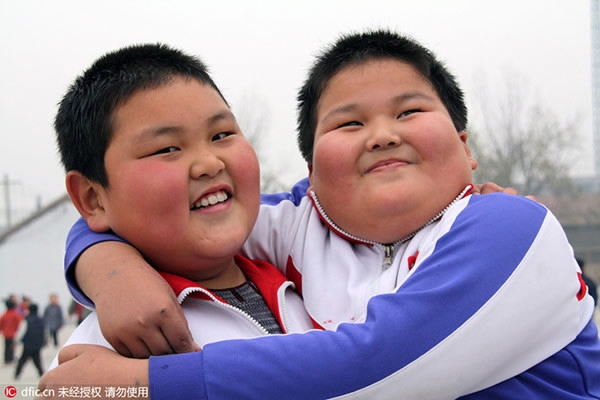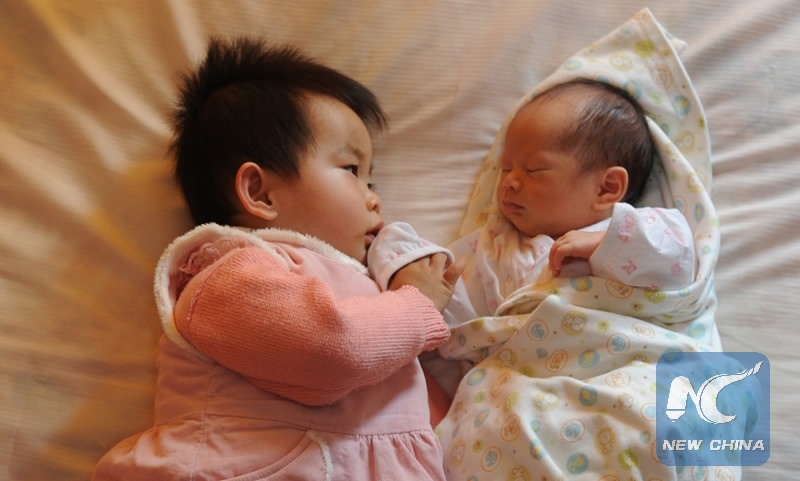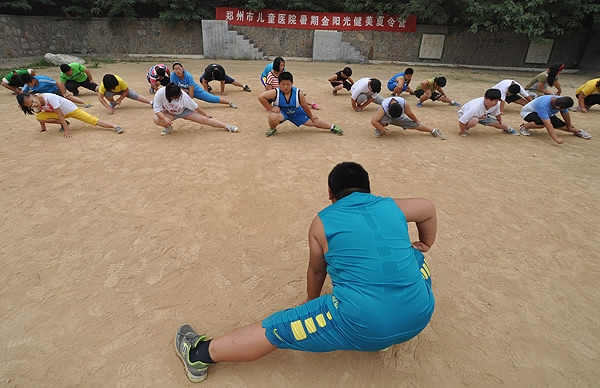China has been groaning under the weight of its child obesity problem, with the government scrambling for solutions to slim down the waists of its youths. A new study offers new nuggets of insight into the expanding problem, with findings showing that single children, especially boys in Chinese urban areas, are at greater risk of putting extra weight than their peers in multi-sibling households.
The
research, published in the December issue of Public Health, assessed the relationship between only-child status and weight and physical activity, and then investigated whether gender and geographical areas impacted such associations.
A group of five researchers from US institutions and Beijing-based Renmin University of China evaluated data from the China Education Panel Survey, the country’s first nationally representative survey of students in middle schools conducted in 2013-14.
A total of 19,487 students from 112 middle schools in 28 regions across China answered the questionnaire. The average age of respondents was 13 at the time.

Students exercise during a campaign to prevent diabetes at a primary school in east China's Shandong Province, November 13, 2008. /Xinhua Photo
Students exercise during a campaign to prevent diabetes at a primary school in east China's Shandong Province, November 13, 2008. /Xinhua Photo
Researchers found that boys without brothers had a higher body mass index (BMI) and were 23 percent more likely to be either overweight or obese than boys with one or more siblings. The situation was more serious in urban households, where brotherless boys were 36 percent more likely to be overweight and 43 percent more likely to be obese than sons with siblings.
Interestingly, for girls, while the risk for sisterless daughters to become obese was 43 percent higher than their counterparts who have sisters, researchers found that the difference was not statistically significant for urban individuals and rural individuals examined separately.
One way to understand such a gender-based discrepancy lies in the traditional Chinese view that believes girls should be thin, according to scientists.
One-child policy consequence?
In the world’s most populous country, being a single child has long been the norm. The one-child policy, introduced in the late 1970s to control a surging population, meant that most urban couples could only conceive one child, while rural families were limited to two, if their first newborn was a girl. The family planning scheme was gradually loosened in recent years, until it was fully scrapped in 2016.

China abandoned the decades-long one-child policy on January 1, 2016. /Xinhua Photo
China abandoned the decades-long one-child policy on January 1, 2016. /Xinhua Photo
The offspring of only-child households in the country enjoyed perks and privileges. They were placed at the heart of the family, with two parents and four grandparents competing to take care of them, and showering them with undivided attention – so excessive that the term "little emperors" was coined to describe single children in China. In a country where extra weight is seen as a sign of health and prosperity, especially for male kids, food became the key to the youngsters' hearts, and a symbol of good parenting.
"Parents tend to spoil their children by feeding them more and better food, which means a greater consumption of high-fat diets in the Chinese context. Meanwhile, many children live with grandparents who tend to over-feed grandchildren," wrote Yang Juhua, who
probed in 2005 the associations between the one-child policy and child obesity in China.
Yang was not alone in being curious about the effects of the policy on the risk of children becoming meaty, but various studies looking at the issue failed to reach a unanimous conclusion on the spiraling rise of pot-bellied "little emperors".

Food, food and more food is one way Chinese grandparents show their love for their only grandchildren. /China Daily Photo
Food, food and more food is one way Chinese grandparents show their love for their only grandchildren. /China Daily Photo
Despite its widespread reach and large sample, "One cannot ascertain causality from this type of study, so it’s not possible to say with certainty that China’s one-child policy was responsible for the results seen in this study,” maintained Ruth Kava in an article on the American Council on Science and Health about the recently published research.
Changing, chubbier China
China's beef with youth obesity goes beyond the number of kids in a household. The crisis is national, and does not discriminate against age.
The waistlines of Chinese, adults and kids alike, are expanding at an explosive pace.
The latest data (May 2017) from the Chinese Center for Disease Control and Prevention show that 30 percent of Chinese adults are overweight, and 11.9 percent are obese. Among children between six and 17 years old, nearly 10 percent are overweight, while 6.4 percent are obese – that compares with just 5.1 percent of overweight children in 2002, and around two percent in the 1980s.
China is already home to the world’s largest population of obese children (15 million in 2015), according to a global report, the "Burden of Disease", published in June this year by the University of Washington in Seattle.
The plumpness plight in the Middle Kingdom is one facet of its socioeconomic development.

A nutritional shift to junk food is a sign of a changing China. /China Daily Photo
A nutritional shift to junk food is a sign of a changing China. /China Daily Photo
China’s meteoric economic growth fueled the rise of people’s living standards and the emergence of consumerism – food is no longer in short supply, and deprivation has long given way to a life of plenty, even in rural areas. The opening-up of the country to the world opened the door to a deluge of fast food chains that made Chinese salivate after diets high in fat and low in fiber, feeding into their desire to adopt more "Western" ways of living.
According to the country’s health watchdog, the average intake of salt for Chinese adults in 2016 was 10.5 grams while the suggested amount according to Chinese Dietary Guidelines was less than six grams. Similarly, the average intake of cooking oil for Chinese adults was 42.1 grams, while the suggested amount was 25 to 30 grams.
The availability, accessibility, and affordability of calorific food in China, coupled with a lack of physical activity expanded the country's army of "xiao pang dun" (little fat kids), notably among single kids.

Too many carbs and not enough fiber make up a recipe for obesity. /China Daily Photo
Too many carbs and not enough fiber make up a recipe for obesity. /China Daily Photo
The recently-published study found that boys without siblings spent less time watching television and browsing the Internet than those who have brothers. Less screen time could have spelled good news had it not been for the fact that single sons were also more inactive than their counterparts with siblings, participating less in after-school sports and household chores.
All the aspirations of Chinese parents usually fall on the shoulders of their only offspring, especially sons, exerting pressure on them to live up to their expectations, argued the researchers. They noted that focusing less on physical exercise allows for more study time as academic excellence is a top priority in Chinese households.
Heavy price
The fast pace at which the upward weight trend is progressing will have dire consequences.
Diabetes is already a cause for concern for the Chinese government, and one report by Peking University’s School of Public Health in May this year showed that youth obesity is eating away at the nation’s economic health. Some 49 billion yuan are expected to be spent on obesity-related chronic illnesses by 2030, more than double the price tag of similar health care services (21.11 billion yuan) in 2002.

The population of obese kids will skyrocket to 50 million by 2030 according to certain estimates, more than the people in Spain. /China Daily Photo
The population of obese kids will skyrocket to 50 million by 2030 according to certain estimates, more than the people in Spain. /China Daily Photo
Alarm bells have already been rung, with the report warning that almost 50 million children, more than the current population of Spain, will be classified as obese or overweight by 2030.
Action time
Beijing has thrown its weight behind the efforts to rein in swollen numbers of chubby children, and introduced measures to promote a more wholesome and nutritional diet.
In July, Chinese authorities released the national nutrition plan for the 2017-2030 period, according to which the rate of obesity among Chinese students needs to slow down by 2020 and be under "effective" control by 2030, Xinhua reported.
The plan urged schools to structure meal plans based on students’ age and the academic institution’s location, raise awareness about healthy diets through educational campaigns, and increase sports activities.
In October, news emerged of a course in Nanjing Agricultural University in east China’s Jiangsu Province that ties students’ weight loss to their marks. Exercises like running on treadmills, walking 10 kilometers twice a week, and going on mountain-climbing trips are all part of the curriculum. Those who shed seven percent of their original weight can pass the course, it was reported.
(With input from Xinhua News Agency)








